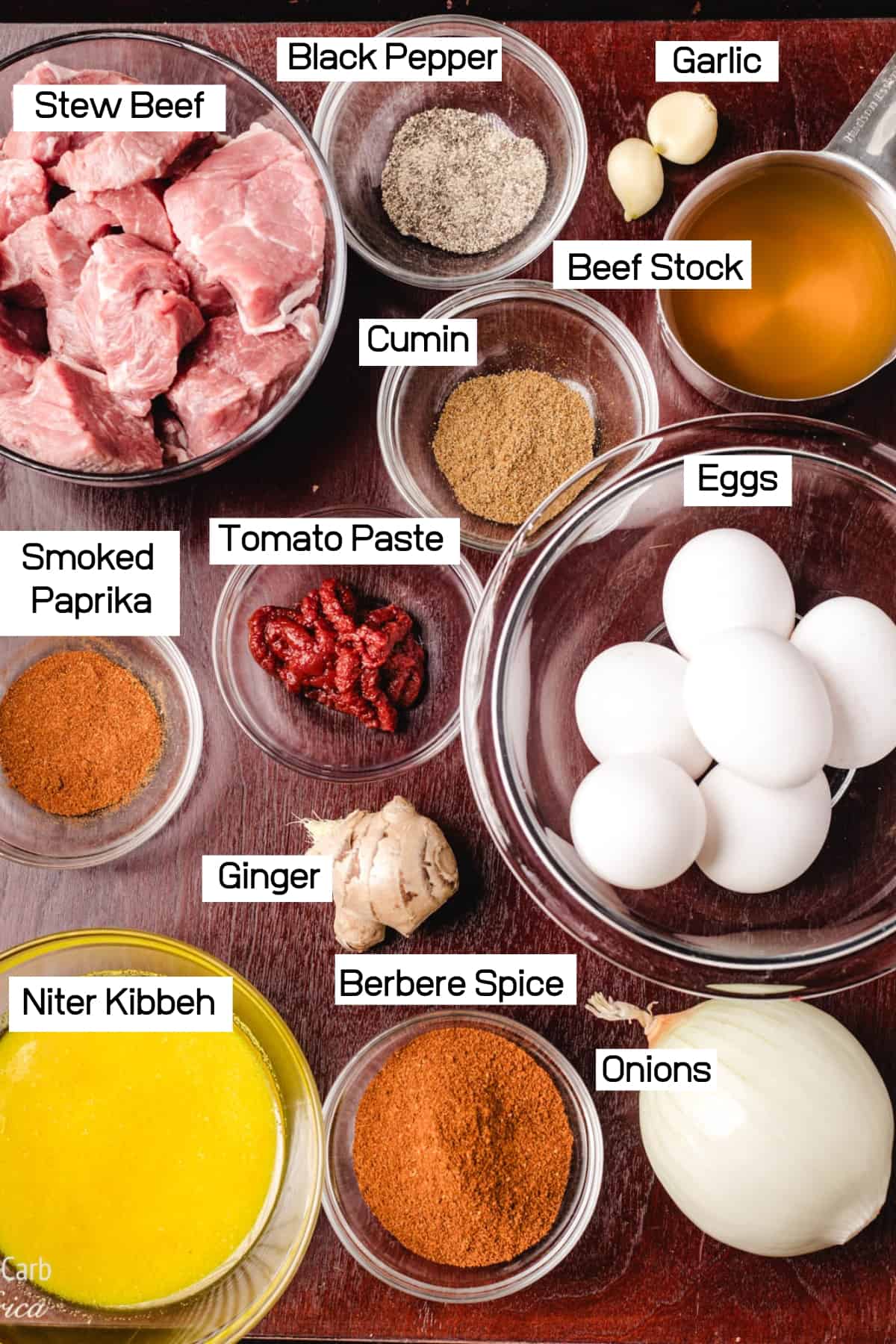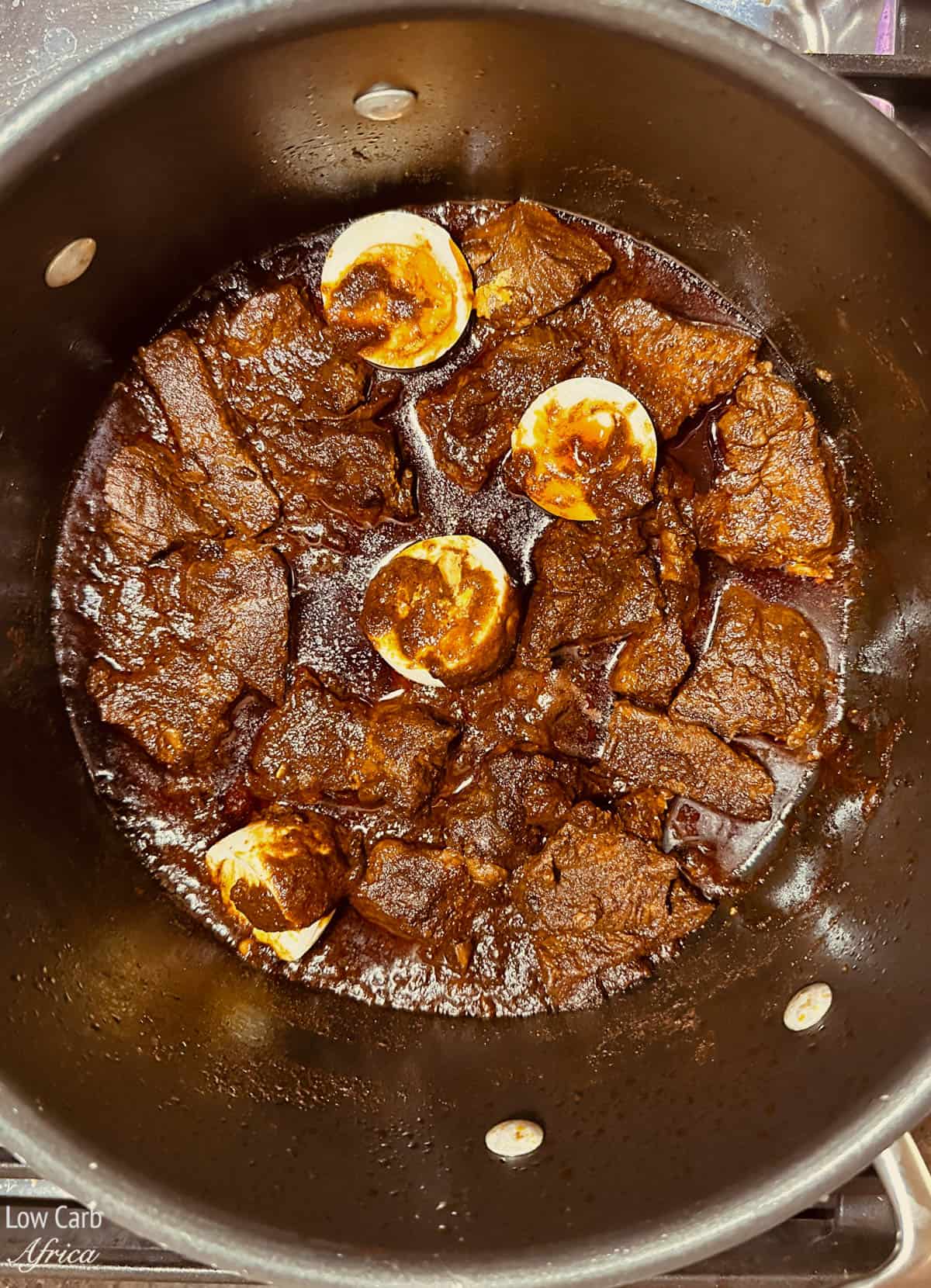Sega Wat (Ethiopian Beef Stew), the heart and soul of Ethiopian cuisine, is a dish that encapsulates centuries of tradition, culture, and flavor. Imagine tender morsels of meat bathed in a rich, aromatic sauce that's been meticulously simmered to perfection.

Want to Save This Recipe?
Enter your email & I'll send it to your inbox. Plus, get great new recipes from me every week!
By submitting this form, you consent to receive emails from Low Carb Africa.
This dish is a culinary journey that takes your taste buds on an adventure through the vibrant and diverse world of Ethiopian food.
Jump to:
❤️ Why you'll love it
Prepare to fall in love with the crown jewel of Ethiopian cuisine. This spicy beef stew, Ethiopia's national dish, is a flavor-packed journey that transports you to the heart of Africa. Its robust flavors, tender beef cubes, and fiery berbere spice mix create a tantalizing experience.
Whether you're savoring it in an Ethiopian restaurant or trying your hand at this easy recipe at home, Sega Wat is a delicious adventure you won't want to miss. And here's a delightful surprise: it tastes even better the next day, making it a rewarding culinary journey that keeps on giving.
🥘 Equipment Used
The following are affiliate links. We are a participant in the Amazon Services LLC Associates Program, an affiliate advertising program designed to provide a means for us to earn fees by linking to Amazon.com and affiliated sites.
To create this flavorful Ethiopian beef stew, you'll need basic kitchen tools like a large pot, a cutting board, and a sharp knife for dicing the beef into inch cubes.
🧾 Ingredients Used

- Chicken thighs: This dish is traditionally made with chicken thighs, but you can substitute it with chicken breast or drumsticks.
- Niter kibbeh: This spiced clarified butter, similar to ghee, serves as the base for this recipe, infusing it with richness and aroma.
- Aromatics: Onions, garlic, and ginger. This fragrant trio forms the foundation of this recipe's flavorful onion mixture.
- Tomato paste: Offering a tangy and savory depth to the stew's sauce, enhancing its authenticity.
- Chicken stock: Provides a flavorful liquid base for this recipe.
- Boiled eggs: A signature addition to this Ethiopian favorite, hard-boiled eggs soak up the sauce's robust flavors.
- Spices: Berbere spice blend, smoked paprika, black pepper, and salt.
🔪 How To Make This Recipe
- Heat a large pot and add the essential niter kibbeh, a key ingredient to a lot of Ethiopian stews. Toss in the finely chopped onions, garlic, and ginger, and let them sizzle until they caramelize.
- Add the berbere spice, smoked paprika, black pepper, and a pinch of salt. Stir for 2-3 minutes. Pour in the stock, along with tomato paste, to create a hearty base. Then, add the tender stew beef cubes to the pot.
- Let the stew simmer gently for about 45 minutes to 1 hour. This allows the beef to reach perfect tenderness while the sauce thickens and develops its robust flavors.
- To add a traditional touch, gently place the boiled eggs into the simmering stew, where they'll soak up the delightful sauce for about 10 minutes on low heat. Before serving, take a moment to taste the stew for spices and adjust according to your preference.

🥫 Storing and Reheating
Sega Wat can be kept in an airtight container in the refrigerator for 3-4 days. You can also freeze it for a few months.
To reheat, let it thaw in the fridge overnight. Then, you can either warm this spicy stew on the stove or reheat it in a microwave.
💭 Tips and Variations
- Swap out the beef for boneless chicken pieces to create Chicken Sega Wat. Adjust the cooking time accordingly, as the chicken cooks faster than beef.
- For a vegetarian option, skip the meat and use extra vegetables like carrots, broccoli, or green beans.
- Experiment with different spice blends if you don't have berbere spice on hand. Garam masala, or a mix of paprika, cayenne, and coriander, can provide unique flavors.
- If you don't have Niter Kibbeh (spiced clarified butter), you can use olive oil or coconut oil as a substitute.

🍽️ What can I eat this recipe with?
Sega Wat pairs beautifully with a variety of sides. Traditional injera, a spongy flatbread, is a classic choice, perfectly complementing the stew's rich flavors.
Teff flour bread like Dabo or Kocho offers an authentic alternative. For non-traditional options, try white rice, crusty bread, couscous, or a fresh salad.
I like to enjoy this dish with cauliflower rice on a low carb diet.
👩🍳 Frequently asked questions
Yes, you can adjust the spice level to your preference by using more or less berbere spice. Keep in mind that this is traditionally a spicy dish.
You can typically find berbere spice mix at international or Ethiopian grocery stores. You can also make your own blend using whole spices.
Yes, Sega Wat often tastes even better the next day as the flavors have a chance to meld. It's a great dish for preparing in advance.
Yes, there are vegetarian versions of Sega Wat known as "Alicha Sega Wat" that use vegetables instead of chicken.

Enjoy these other African dishes!
Doro Wat (Ethiopian Chicken Stew)
📖 Recipe

Sega Wat (Ethiopian Beef Stew)
Ingredients
- 1.5 lbs stew beef
- 4 tablespoon niter kibbeh Ethiopian spiced butter
- 6 large eggs boiled
- 1 onion
- 4 cloves garlic
- 1 tablespoon ginger chopped, approx one thumb
- 2 cups beef stock
- 1 tablespoon tomato paste
- 4 tablespoon berbere spice
- 1 tablespoon smoked paprika
- 1 teaspoon black pepper
- ½ teaspoon cumin
- 1 teaspoon salt
Instructions
- Heat a large pot and add the niter kibbeh.
- Toss in the chopped onions, garlic, and ginger, and let them sizzle until they caramelize.
- Add the berbere spice, smoked paprika, black pepper, and a pinch of salt. Stir for 2-3 minutes.
- Pour in the stock, along with tomato paste, to create a hearty base. Then, add the tender stew beef cubes to the pot.
- Let the stew simmer gently for about 45 minutes to 1 hour.
- Place the boiled eggs into the simmering stew and simmer for about 10 minutes on low heat.
- Taste for spices and adjust according to your preference.
Notes
- Swap out the beef for boneless chicken pieces to create Chicken Sega Wat. Adjust the cooking time accordingly, as the chicken cooks faster than beef.
- For a vegetarian option, skip the meat and use extra vegetables like carrots, broccoli, or green beans.
- Experiment with different spice blends if you don't have berbere spice on hand. Garam masala, or a mix of paprika, cayenne, and coriander, can provide unique flavors.
- If you don't have Niter Kibbeh (spiced clarified butter), you can use olive oil or coconut oil as a substitute.
Nutrition
Spice up your dishes with these delectable sauces and seasonings!



















Comments
No Comments